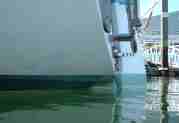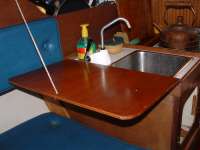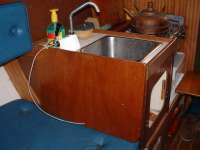

![[GK24 logo]](gk24logo.gif) Westerly GK24
Westerly GK24The story of the GK24 began with the prototype : Chris Hawkins' IOR 'quarter tonner' boat 'Ebblake IV' built in cold-moulded mahogany at Aquaboats, which was raced successfully in the Solent.
Westerly's liked the design and decided to put it into production as
the GK24. Chris Hawkins worked with Peter Anstey at Laurent Giles to
create
the production version, changing the deck to provide a window into the
interior and a little more headroom
Chris then raced a production GK24, 'GateKrasher'.
GateKrasher was also a success and Chris won races against top
Quarter Ton boats (including a recent World Quarter ton
champion,'Genie' designed by Farr).
While he was winning races, Chris always raced with all anchors,
chain, warps, fenders, bunks and cushions and crew kit on board. The
boat was not stripped out for racing.
Chris's most recent production design is for the Hawk 20 which is a 'self-righting' 'unsinkable' dayboat which has sold over 200, as both a pleasure boat and a sail training boat.
There were still enough around racong in 1998 for there to have been a national championship ( 1998 at Dartmouth 27-30 July, and subsequently, a GK24 trophy inside class 3 at Dartmouth Week) and a there is still separate result for CHS rated GK24's in the Round The Island Race. (Isle of Wight)
The Class Association, the 'GK24 Register' from 1998 to 2004
was in
suspension, as the previous Secretary did not own a GK24 any more.
However, in 2001
, Mr Amos of the Class Association in Falmouth had taken over the
Register,
and was collecting information from current GK24 owners to keep the
Register
up to date.
He reluctantly sold his boat in 2004 as by then he was racing alone
against J/24s at Falmouth, so he had to get one to continue racing
competitively.
It was the sale of Golf Kilo that resulted in the picture which I
took of her under new ownership off St Cats in the RTI.
We propose to try and encourage all GK24's entering in e.g. RTI to
enter in the same fleet so that we can actually race against each
other, rather than in 2 different classes (ISC and IRC)
The GK24OA have decided on the location and time of our launch
party. We hope to get as many boats togerther as possible on
the afternoon of Saturday 16th April in Portsmouth
Harbour.
Probably at Haslar Marina.
The GK24's seem to have retained their popularity over some more
outright racers from that period because their heavier displacement and
interior layout allows them to be used as a small cruiser, which is
their main role these days.
Outside of the Solent which is sometimes like a lake with a
waterfall at
one end (Hurst narrows/Needles channel), the better seakeeping of boats
such
as the GK24 allows them to still exist in the club racing scene
occupied by
sportsboats in the Solent. As a result, there are still small racing
fleets in the West Country.
They are also to be found in Wales and Scotland .
'Selling 3 a week' : 'less a Ferrari, more the MGB-GT of racing boats'.Practical Boat Owner 1998
More retrospective, the only Westerly to 'make a name for itself' racing.
Sailing Today 2001
Best of all, Forethought, our own boat was reviewed in 2001 in Sailing Today.
My review here
There are several basic variants of the GK24, at least we have encountered these on our trails around the broker's lists, and on details on entry forms for the National Championships, and CHS forms that I filled in.
LOA : 7.32m
..... .boat here ......

The white antifoul is where I am finishing off a tin of white antifouling in areas where the usual stuff has eroded back to epoxy.
This collection of figures gives a CHS rating of about 0.83 (25 year
old design !)
Layout indicates 5 persons could sleep aboard. Realistically 3
could sleep without elbows/legs collisions. We are looking at extending
the starboard berth into a double for small people with an extra
cushion and
a piece of plywood to make extra berth space.
There is a sink, with a hand water pump. We have fitted an in-line
filter and a secret shutoff valve, as the supply of water is quickly
used up for play.
As the work top is minimal (behind the sink, about 15 cm by 30cm) I
made up a hinged plywood panel which is screwed to the after side of
the sink
pedestal. This is held up with a cord to a lacing hook high up on the
locker
side. This panel is 45 cm by 30 cm and is angled towards the sink, at
least
when the boat is flat ! It has supported a baby in a table-edge seat.
If a 15 stone bloke sits on it it comes unstuck in an explosion of
wooden trim pieces.


We replaced a Camping Gaz swinging bottle two ring gas cooker with
an
Origo methylated spirits cooker, as it was condemned by the surveyor.
Fortunately we found somebody selling these off at 1977 prices in 2002.
He had found a job lot in his garage, and we got the gimbals, pan
clamps and cooker for £75
We
cleaned up the old cooker and made some legs for it and now we take it
camping.
We did have a problem with the Origo when we managed to drop some
embers from a match head on the top of the fuel container's
gauze. The ember stayed alight all night fuelled by the alcohol,
with the burner shut off . The cooker burst back into life
without the need for any ignition
source in the morning. This doesnt usually happen, as we use a gas
match
type of lighter. Using disposable lighters is painful and rather
dangerous
as it takes a while for the alcohol to get going on a cold day by which
time your fingers are cooking. Matches thrown in work much better.
There is a sea toilet (squeeze around behind the mast). It
is a hybrid of two different parts, a bowl from 'Tuffy' and a modern
pump
and base from Jabsco, for spare part availability reasons (I broke the
original seat base/pump in the hours before our first big cruise in
1997).
We have fitted a grab handle for more confidence, and stuff
fenders and buckets behind so that it is less likely that one falls off
it.
Water is held in a rather small 25L bungee-retained jerrycan
which falls over at 30°ree; of heel. Fortunately it only holds
25L. A recent upgrade is to put an additional pair of plastic 25L
containers into locker for cruising use, giving 75L total. These are
normally kept
empty for racing. To hold up the collection of cans, I use sail
ties.
A reasonable amount of locker space is provided but the rather flat
profile of the hull means that some of the lockers are only a few
inches deep.
There are no 'bilges' to collect water as such, rather a series of
rectangular 'cells' each one of which is independent. This is due to
the lateral and fore and aft reinforcement of the keel attachment
points. Losing a litre of water into the bilges can be a heart-stopping
experience as it starts to run around the floor.
Masthead (deck stepped) or 3/4 fractional rig (keel stepped)
![[Picture of A GK24]](fore.gif)
This picture was taken in 1996. See the Forethought
of Gosport
page
for the story of the progress with our GK24.
I'm not an old salt but here's a few things we've picked up along the way.
When we are at anchor, the boat rolls horribly. I have almost fallen off as Forethought rolled when a motor yacht passed us while we were anchored in the lee of Hurst Castle. More experience and it doesnt seem as terrifying any more.
We found that an effective roll damper is a plastic bucket on a 3 foot rope with something fairly heavy in it to make it sink. We use an odd length of chain. The rope is tied to a stanchion at the point of maximum beam, and the bucket is filled with water and then allowed to sink. The bucket stays underwater and as its so aerodynamically horrible it rapidly damps out the rolling. It hangs low enough in the water not to bang the hull if we do roll.
I remember to take the bucket up before we leave the anchorage
because we use the bucket to transport the anchor chain down below and
to a locker. This is always preceded by a panicky hunt for the bucket,
at least in my mind !
[top]
One of our stanchion bases was cracked and eventually gave up the ghost, assisted by the side of the finishing barge in the Round the Island race. The laminate surrounding that base was pretty cracked as well : water leaked down inside the hull.
I replaced it successfully with a new almost identical base that I bought at the Yachtmail (now Aladdins Cave) chandlery at Hamble Point. However, the only trouble is that the three fixing holes are in different places. All but one bolt can be persuaded to go back in the same place. This needed a new hole to be drilled and the old one to be filled.
This breakage is due to the fact that the stanchions situated at maximum beam are angled outwards.
This makes them the first thing to contact a vertical quayside when
not properly fendered.
Since this breakage, I have had one stanchion totally removed by a
bow-mounted anchor on a Moody. This left a neat hole so I was able to
rebuild the deck from underneath. I managed in time for the Round
the Island race but I came close to bolting in a temporary structure of
plywood to do instead.
Basically I cut away the lower side of the deck laminate for about
10 cm around the stanchion base, removed the balsa mush, and then made
a piece of 10mm plywood to fit the hole. I then chamfered the
edge of the plywood back down to flush with the bottom of the original
laminate and then used 3 layers of woven mat with epoxy to fix it back.
Late 2002: The same stanchion has been ripped off again, by my
neighbour in Port Hamble. He did not bother to admit it and I resent
this somewhat. This time all that went was the stanchion base.
I had to hacksaw the old base off the stanchion, as it was
locked on with salt and corrosion. Then I needed to fill and finish the
deck damage caused by smashed metal gouging the deck.
[top]